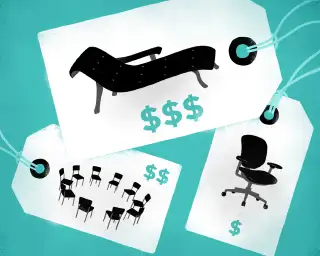5 Ways to Save on the Mental-Health Care You Need

Affordable mental-health care has been easier to come by in recent years. Insurance coverage, once riddled with onerous caps and restrictions, is now more widely available. “Things have gotten better for many,” says Andrew Sperling, director of federal advocacy at the National Alliance on Mental Illness.
Still, paying for care can be a challenge. The high out-of-pocket costs that you’re facing for all your health care extend to behavioral coverage too. And low reimbursement rates and billing hassles have led many therapists to not take insurance. A study published last year in the journal JAMA Psychiatry found that only 55% of psychiatrists accept private insurance; for all other medical specialties, that figure is 89%.
Here’s what you need to know about finding the best treatment at the best price.
Insurance Options are Better
Under a 2008 law that took effect in 2010, health plans offered by large employers that include mental-health coverage must treat it like other medical care. So a plan can’t cap annual visits or impose prior authorization rules for behavioral health if it doesn’t do the same for other illnesses, says Jennifer Mathis, director of programs at the Bazelon Center for Mental Health Law. Co-insurance rates have to be the same too. As the graphic above shows, the parity law hasn’t discouraged employers from offering coverage.
Any individual plan you buy on a state insurance exchange must include mental-health coverage; it’s one of the 10 essential benefits required by Obamacare. The provision in the law that lets children stay on a parent’s health plan until age 26 is another boon, since most major psychiatric conditions show up in late adolescence or early adulthood, notes Debbie Plotnick, senior director of state policy at the nonprofit Mental Health America.
Medicare coverage is also better. As of 2014, beneficiaries are responsible for only 20% of mental-health costs, down from 50%.
Your Employer Can Often Help
Especially if you have a high-deductible health plan, start with your company’s employee assistance program, says Kathleen Mahieu, leader of behavioral-health consulting at benefits consultancy Aon Hewitt.
About three-quarters of employers offer an EAP. These programs typically provide five or six sessions of no-cost counseling, even for family members. That’s enough for some people to resolve their issues, says Katherine Nordal, the American Psychological Association’s executive director for professional practice. An EAP can help you find a provider or connect you with other mental-health resources. “It’s a one-stop shop,” says Mahieu. And, she adds, EAPs pride themselves on confidentiality. Your boss won’t know, and you don’t even have to give your name.
Your Bill is Negotiable
When your therapist isn’t in your insurance network, you’ll have to pay upfront and submit the bills for partial payment (assuming you have out-of-network coverage) or, if you’re in an HMO, pay in full. Even if you are reimbursed, you won’t get back, say, 70% of the bill. You’ll get 70% of what the insurer considers “reasonable and customary,” leaving you on the hook for the rest.
If you can’t find an appropriate provider in your plan, ask your insurer to negotiate what’s known as a single-case agreement with someone who’s not in your network, says Barbara Griswold, a licensed marriage and family therapist in San Jose. That would let you to pay the in-network rate.
You can also ask about a reduced fee, says Griswold. “Almost every therapist has a sliding scale,” she says. Be realistic about what you’ll be able to afford and how long you’re likely to want therapy.
You Have Other Ways to Save
A university with a graduate psychology program may have a clinic, says the APA’s Nordal. Care is provided by doctoral trainees who are supervised by licensed psychologists. In an urban area, you may be able to find postgraduate training programs in psychoanalysis or cognitive behavioral therapy for experienced psychologists, says Geoffrey Steinberg, a licensed psychologist in New York City. (Google “training clinic” and the specialty you’re looking for.)
Another option: Ask your therapist if your condition might benefit from group therapy led by an experienced psychologist, which can be 50% less expensive than one-on-one sessions. Says Steinberg, “Group is so underrated and can be so valuable.”
Know Which Treatment Is Best for You
“No single therapy works for everybody,” says Renée Binder of the University of California at San Francisco’s School of Medicine. Consider these approaches for five common conditions.
1. Mild to moderate depression: Go for cognitive behavioral therapy (CBT). “A therapist works with you to break negative thought patterns by teaching specific skills,” says Binder. You might learn, for example, to ID overly critical self-talk (“Everything I do gets screwed up”) and reframe it in a positive way (“I flubbed a presentation, but I know I can rock it next time.”)
2. Severe depression: Combining antidepressants with CBT is better than meds alone, a recent Vanderbilt University study found. You need to see an MD or a psychiatric mental-health nurse practitioner for the prescription, but you can get therapy from a social worker or a psychologist.
3. Social anxiety: Your best bet is either CBT or psychodynamic therapy (in which you explore how your past experiences and unconscious affect you). In a study published in July in the American Journal of Psychiatry, these methods were equally effective at easing social anxiety.
4. Panic attacks: CBT is usually the treatment of choice. Some research suggests psychodynamic therapy may also work: A Weill Cornell Medical College study found that 12 weeks of biweekly sessions significantly reduced symptoms in more than 70% of patients. Medications may also be used.
5. Trauma: Look for a therapist who offers trauma-focused CBT or EMDR, which stands for eye movement desensitization and reprocessing (you’re asked to recollect the event while doing a motor task such as side-to-side eye movements). “Antidepressants and anti-anxiety meds are helpful in the short term, but therapy works to change thought patterns long term,” says Binder.